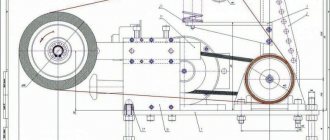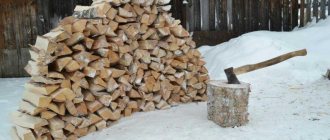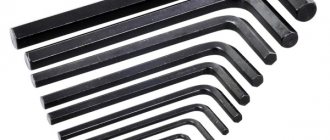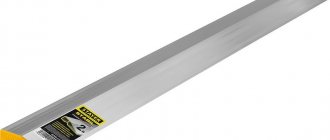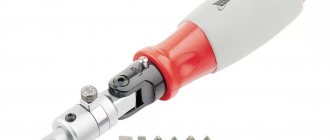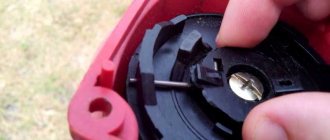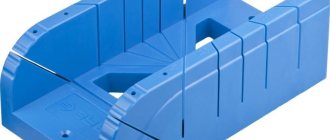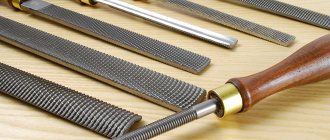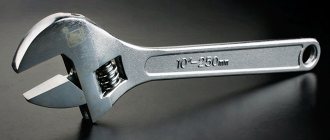Savig
4568 0 0
Savig August 10, 2017Specialization: master of interior finishing works. I am well versed in power tools for repair and construction. Formerly a teacher at a radio engineering college.
Sometimes a hammer is not enough during dismantling or installation work on a construction site or on your own country site. In such cases, a sledgehammer comes to the rescue. And so that this percussion instrument does not fail at the most crucial moment, it must be chosen correctly. For this purpose, we have collected and reviewed the most popular samples.
Here are the results of our test - the 2 best options:
| Illustration | Main Characteristics |
| To support construction work on your own country site and solve simple everyday problems: Stayer Profi Advantages:
Price : 560 rubles. | |
| For use on serious construction sites and solving complex professional problems: Matrix 10924 Advantages:
Price : 1420 rubles. |
What is a sledgehammer
Most often, this important tool consists of only two parts. Judging by the translation of this word, it can be understood that the sledgehammer was a common tool used only by blacksmiths. Nowadays, its functions have expanded somewhat - now it is needed in those jobs where it is necessary to carry out a strong blow.
It is suitable for creating metal products; large elements are hammered into it, and metal sheets are leveled without any damage. With this tool, athletes strengthen the muscles of their arms and back.
Sledgehammer: design features, varieties
A sledge hammer is a hand-held impact tool that is used in processes where it is necessary to deliver the strongest possible blows, for example, when performing construction work or when working with metal products. At its core, a sledgehammer is the same as a hammer, the only difference is in size, weight and some design details.
For the manufacture of sledgehammers, steel grades 40 and 45 are used, in some cases grades 50 and U7 can be used. The significant weight of the striker, which reaches 16 kg, and the elongated handle with a length reaching 1.2 m, provide a good swing when working with a sledgehammer and, as a result, a blow of significant force. One of the differences between a sledgehammer and a hammer is the design of the handle, which in the first tool thickens closer to the striker, in the second, on the contrary, it narrows. Another feature of the sledgehammer is that the handle in the striker does not wedge, so in case of a miss, the tool will simply fly out of the hands without dragging the worker along with it.
The impact surface of the tool is hardened to a depth of 30 mm, thereby achieving a hardness level of HRC of 32-33 units.
Today on the market of tools and devices you can find a huge number of different types of sledgehammers, but 3 types are most widespread:
- blunt-nosed sledgehammer – weight is 2-16 kg;
- sharp-nosed transverse sledgehammer – weight is 3-8 kg;
- sharp-nosed longitudinal sledgehammer - the weight is the same as a transverse tool.
Types of sledgehammer
For the manufacture of such tools, GOSTs 1140 and 11402 are used.
The products themselves are divided into three types:
- Blunt - reaches a weight of up to 16 kg. maximum. Its ends are cut to an angle of 90 degrees;
- Transverse sharp-nosed - this species weighs about 3-8 kilograms. The element of the mechanism that transmits the impact is sharp on one side and blunt on the other;
- Longitudinal sharp-nosed - it weighs about 8 kilograms. One transverse edge of an extended object is blunt, the second, like an axe, is pointed.
The sledgehammer handles differ in the material used:
- Made of composite plastic;
- Made of wood;
- Made from fiberglass.
According to the production method, products are divided into:
- Forged;
- Cast.
Rating of the best sledgehammers
| Nomination | Place | Name | Price |
| The best blunt-nosed sledgehammers | 1 | matrix 10962 | 2 087 ₽ |
| 2 | Vira 905000 | 2 179 ₽ | |
| 3 | BISON 20111-5 | 2 309 ₽ | |
| 4 | Harden 590306 | 1 665 ₽ | |
| 5 | SIBIN 20133-5 | 902 ₽ | |
| 6 | Sparta 10917 | 656 ₽ | |
| 7 | matrix 10920 | 711 ₽ | |
| Best Pointed Sledgehammers | 1 | FISKARS 1020219 | 4 550 ₽ |
| 2 | Kapriol 12311 | 3 627 ₽ |
Longitudinal sledgehammer with sharp nose
The striking part of this type of instrument is parallel to the handle. The firing pin on one side is made in the form of a chamfered square, on the other it is similar to an ax.
This sharp-nosed product is used to hammer nails, split concrete structures or wood, and even chop firewood.
How to choose a sledgehammer
- First, they stop at choosing the mass and shape of the striking part of the instrument. You can purchase a sledgehammer with a combined striker. One part has a pointed shape, the second is made of a flat square. Such a multifunctional item will be a good helper in repairing a car or destroying a structure. Builders and blacksmiths most often work with blunt-nosed sledgehammers, because they need this tool for a strong blow;
- The material of the head is also important. In order for the tool to retain its original appearance after long periods of impact work, so that hard parts do not damage its working part, I use special types of steel to make the head, which is subsequently forged for strengthening. To ensure the strength of the working surface, selective hardening is done with high-frequency currents;
You need to choose a tool with a good handle - it not only regulates the impact force, but also ensures the safety of the worker. The most affordable ones are wooden handles - they are made of walnut, beech or birch.
- They are quite reliable and easy to repair.
- But the varnish coating does not last long, and the wood does not interfere with the impact on the hands.
- It is better to take an impact object with a fiberglass handle - it is a guarantee of strength, safety and convenience.
- In addition, there is a rubberized insert that improves hand grip with the tool itself.
The best blunt-nosed sledgehammers
Blunt-nosed sledgehammers help break old building foundations, drive stakes and posts into the ground, and repair a car. They have both strikers of a flat or slightly convex shape. The following models have proven themselves well in Russia.
matrix 10962
Rating: 4.9
The blunt-nosed sledgehammer matrix 10962 can be a powerful destructive or creative impact tool. Experts note the successful combination of the large weight of the striker (8 kg) and the long handle (900 mm), which allows you to generate a powerful impact. The long service life of the tool is ensured by a forged head made of 45 carbon steel with a hardness of 52 HRC. It is securely attached to the fiberglass handle. The manufacturer attached a rubber coating to the handle. On the one hand, it provides a safe grip, on the other hand, it dampens recoil. The firing pin has a slightly convex shape, the surface is perfectly polished. The model becomes the winner in its category.
In reviews, owners praise the sledgehammer for its power, reliability and ease of use. The disadvantages include the high price.
Advantages
- solid heavy striker;
- long ergonomic handle;
- reliable assembly;
- durability.
Flaws
- high price.
Vira 905000
Rating: 4.8
The Russian-Chinese sledgehammer Vira 905000 is very popular in our country, despite its rather impressive cost. Experts explain this fact by the optimal ratio of the weight of the striker (5 kg) and the length of the handle (885 mm). The tool is perfect for everyday purposes; you can use it to both destroy and create. To make the head, the manufacturer used CS 45 steel; thanks to heat treatment, the hardness was brought to 50-58 Rockwell HRC units. But the sledgehammer is not only wear-resistant and durable, it is also easy to use. This is thanks to the fiberglass handle coated with thermoplastic rubber.
Judging by the comments on the RuNet, the model is worthy only of praise. She is reliable and tenacious. For some users, only the handle coating was worn out.
Advantages
- strength;
- good combination of weight and length;
- rubberized handle;
- beautiful appearance.
Flaws
- high price;
- short-lived handle coating.
BISON 20111-5
Rating: 4.7
Another Russian-Chinese product made it to the prize podium. The ZUBR 20111-5 sledgehammer with a square striker is a powerful impact tool. The head is made of 55 tool steel and is induction hardened to increase the strength of the working surfaces. Experts appreciated the modern ABT technology, which was implemented in the manufacture of the fiberglass handle. Thanks to the rubberized pad, the sledgehammer fits comfortably in your hands and absorbs vibration during operation. The high impact force is generated by the combination of a heavy head (5 kg) and a long handle (900 mm). Two separate elements are connected securely.
The new product does not yet have reviews in RuNet. However, it should soon take pride of place in the garages and workshops of domestic users.
Advantages
- durable head;
- comfortable handle;
- reliable connection;
- a strong beat.
Flaws
- high price;
- no reviews.
Harden 590306
Rating: 4.6
A modern impact tool is the Chinese Harden 590306 sledgehammer. The head is made of high-strength CS-55 steel, which contains alloying additives such as chromium and nickel. The model is slightly inferior to the leaders in hardness (48 HRC) and weight (3 kg). But due to the long handle (880 mm), it is possible to deliver strong blows to building foundations. The manufacturer preferred a round shape of the striker, and in order not to damage the handle near the head, he installed a rubber stop. The fiberglass handle has a rubber coating, which improves the grip and eliminates vibration. The instrument stops one step from the prize podium.
In reviews, consumers praise the sledgehammer for its ease of use, durable striker, and rubber stop. Not everyone liked the shape of the head.
Advantages
- durable head;
- rubberized handle;
- elastic limiter;
- ease of use.
Flaws
- low hardness of the striker.
SIBIN 20133-5
Rating: 4.5
The Russian SIBIN 20133-5 sledgehammer combines high impact force and an affordable price. The working part is a 5-kilogram head made of 45 steel. It adequately withstands high loads. The firing pin has a square shape; the manufacturer applied a paint coating to protect it from corrosion. The handle is made of birch, the wood is well processed and coated with a special varnish. With a handle length of 600 mm, the lever is large enough to deliver a powerful blow. Experts note a good connection between the handle and the head, but the user will have to check that there are no backlashes before starting work.
Domestic owners managed to test the sledgehammer in action. They were pleased with the durability, low price and lack of recoil. But the quality of the paintwork leaves much to be desired.
Advantages
- affordable price;
- high impact force;
- durable striker;
- securely placed handle.
Flaws
- there are streaks of paint and varnish;
- slippery handle.
Sparta 10917
Rating: 4.4
Among the compact sledgehammers, which are held with one hand, the German-Chinese product Sparta 10917 stands out. The tool is inexpensive, but experts note the high quality of workmanship. The working part is made of steel 45, the surface of the striker has a hardness of 52 HRC. The square-shaped head is slightly convex and is ground on both sides. Black varnish provides protection against corrosion to the head. The 286 mm long fiberglass handle absorbs shock well. This is facilitated by the rubber coating; it is responsible for a comfortable and reliable grip. The connection between the handle and the head is immobile and durable. The model closes the TOP 6 of our review.
On thematic forums, the tool is praised for its ease of use, beautiful appearance, and affordable price. But the rubber coating peels off over time.
Advantages
- high-quality assembly;
- compactness;
- hard striker;
- comfortable handle.
Flaws
- short-lived handle coating.
matrix 10920
Rating: 4.3
At the lowest price you can buy a matrix 10920 sledgehammer in Russia. This is a fairly light tool (1.5 kg), which is close to a heavy hammer. Experts liked the German development of a forged head, the striker of which has high hardness (52 HRC). The working surface is polished on both sides. The square-shaped steel element is protected from corrosion by black varnish. The quality of the Chinese assembly was also excellent. The fiberglass handle has a rubber coating that softens the impact and makes the grip safe. The length of the handle is 297 mm.
Domestic users tested the tool on construction sites and during car repairs. They are satisfied with the ease of use, affordable price, and durable head. The downside is the appearance of rust on the strikers.
Advantages
- low price;
- lightness and compactness;
- comfortable handle;
- hard striker.
Flaws
- rust appears on the strikers.
Sledgehammer training
There is such a wonderful exercise program as CrossFit. It includes a number of anaerobic, gymnastic and weightlifting exercises and is aimed at building endurance.
Here you can use the simplest equipment available at home. Powerful hits with a sledgehammer on a tire will not only strengthen your muscles and make them grow, but will also help your body burn extra calories much faster and more efficiently than treadmills and exercise bikes.
By performing numerous blows with a sledgehammer, you will train the muscles of the front part of the body for endurance. You can train each hand in turn.
When working with the legs, you need to make sure that the legs are well secured and will not be hit by the hammer. You can put your feet wider and hit from above from behind your head, aligning your body.
Technique for performing exercises with a sledgehammer
This seemingly easy type of exercise requires good dedication and requires the implementation of a number of certain rules:
- You need to stand up, straighten your back, place your legs parallel to each other. In this position, grab the end of the tool at a half-meter distance from the tire, hold it tightly in your hands;
- Swing and rotate in a circle over your left shoulder. The right palm should be placed closer to the end of the hammer. Each time you need to change the position of your hands. Do it slowly at first, and then everything will work out automatically;
- Swings must be performed not only with your hands, but with your whole body at the highest possible speed;
- If the hammer creates a perpendicular to the floor, this is a sign that you need to stop and stop swinging, lowering the sledgehammer down, and very quickly - for the power of the blow. It's like cutting down wood;
- After hitting the tire, you need to straighten your lower back, otherwise wait for the imprint of a sledgehammer on your forehead!
Beginners can perform a simplified type of exercise:
- Strike from the left side - 15 times in each direction;
- Strike from the right side - 15 times in each direction;
- Hit from head height - 15 times in each direction.
Of course, when performing exercises, first of all, be guided by your physical capabilities and health.
You can do fewer approaches if this amount is not yet acceptable for you and gradually add them. You can rest no more than 15 seconds between rounds.
Tools
0 votes
+
Vote for!
—
Vote against!
Dismantling, working with reinforcement, hammering fasteners, crumbling and crushing stones, straightening and other heavy manual work cannot be done without the use of a metal sledgehammer. A reliable tool allows you to perform all these tasks as easily and comfortably as possible. Only through the use of such a seemingly simple hand tool will it be possible to achieve maximum productivity and efficiency.
Purpose of the sledgehammer
The sledgehammer is one of the ancient construction tools. Various primitive hammers have been known for a very long time and have survived to this day only in a refined form. One of the ancient varieties of this tool is the sledgehammer, which is still widely used today to perform rough operations.
For example, a sledgehammer can be used when destroying a block of stone or concrete, when hammering massive and heavy metal elements, and when carrying out other similar work. The very name of the sledgehammer seems to hint at the use of this tool in blacksmithing. The date of birth, accordingly, can be attributed, at a minimum, to the Bronze Age. The striker of this instrument was a stone, and the handle was a human hand.
However, it was the invention of the lever that changed the appearance of the sledgehammer: they began to attach a wooden stick to the stone. The joining method chosen by our ancestors anticipated the way the handle is attached in our time. But there was another method: they chose a stone with a hole that would be suitable in weight and size for the striker. And then this stone was placed on a tree branch and waited until the branch grew and was securely fixed in the head of the sledgehammer.
Thus, a tool has survived to this day that performs many jobs. Despite global computerization, the use of robots in industry and worldwide progress, nothing can yet replace the sledgehammer. A construction sledgehammer (two-handed hammer) is a hand-held impact tool that is designed for work that requires the greatest impact force. The main area of application for sledgehammers is free forging using a forging tool.
It also involves delivering strong blows during the installation and dismantling of various communications, metal processing, driving staples, pins, wedges and thick nails into massive logs, knocking out various stuck fasteners, breaking concrete products, bricks and stones when destroying small buildings. It is very convenient to carry out these works when using a sledgehammer with a striker that has a serrated surface.
The sledgehammer is also intended for driving wedges, stakes, piles and poles into the ground; it can be used in construction work, beating tires when dismantling wheels and straightening during car body repairs, straightening metal sheets and blanks, crushing stones into crushed stone (although this method is a bit became obsolete after more productive stone crushers were introduced into quarries). It is also common to use a sledgehammer by cupola workers when knocking castings out of flasks and beating the gating system away from castings.
Sledgehammer design
The design of the sledgehammer is effective and simple. It consists of a striker and a handle. A sledgehammer is constructed to some extent similar to an ordinary hammer, but at the same time has an increased mass of the striker (usually more than 5 kilograms), which is made in the form of a parallelepiped, and an elongated and thick handle on average up to 70-90 centimeters. The weight of the striker, depending on the specification of use of the sledgehammer, can even reach up to 16 kilograms, and the length of the sledgehammer handle can be up to 120 centimeters.
The handle, according to the drawing of the sledgehammer, thickens towards the striker (the handle of the hammer tapers towards the striker) and does not wedge in it. This is also done so that if the sledgehammer misses, it can fly out of the hand and not drag the worker down with it. Due to these differences, a sledgehammer is able to deliver more powerful blows to the surface being treated.
The sledge hammer head is the center of gravity during operation and provides the main shock loads. The handle plays the role of a lever, and in some cases it can be short: when you plan to work in limited space, it is better to choose a sledgehammer with a short handle.
Unlike a hammer, a sledgehammer has a number of advantages: you can hammer in any nail with one blow, provided it hits the target area exactly. Plus, you have the choice of the right tool to solve your problem. If impact force is important to you, you should choose a tool with a larger striker mass and a long handle, which also increases the impact leverage. The smaller the striker has mass, the more accurately you can strike, and the work process will not require much effort.
Types of sledgehammer
Construction sledgehammers differ in length, type and material of the handle, weight, shape, type of hardening and grade of metal of the striker. A real sledgehammer has a handle that is made of shock-absorbing material - wood, fiberglass or composite plastic. Wooden handles should also be made from hardwoods such as pear, dogwood, and acacia.
Typically, the grip area of the handle is covered with a rubber-based material. This is necessary to partially remove vibration and reduce the sliding of hands along the handle. But sledgehammers with a metal handle give “recoil” to the body and hands when working, so working with such a tool is not safe and comfortable due to harm to the musculoskeletal system; it is better to choose a sledgehammer with a wooden handle. The handle can be straight or anatomical in shape.
Since sledgehammer strikers experience high dynamic loads during operation, they are usually made of hard steel grades that have a high carbon content (close to 1%) - the element responsible for hardness. Such steels are called carbon tool steels and are marked U12A, U10, U7 and U7A. Working surfaces are necessarily hardened to a depth of 30 millimeters to a hardness of HRC 32.5.
In some cases, the sledgehammer head weighs up to 15 kg. The inner part of the metal striker in the most advanced models is filled with steel balls. This makes it possible to prevent the sledgehammer from being thrown back after an impact, as does its handle, which is thicker towards the striker. Currently, the appearance of the sledgehammer has also changed. This instrument is available in a variety of colors using modern high-tech materials.
Based on the manufacturing method, there are two types of sledgehammers - forged and cast. Structurally, sledgehammers are divided into certain types: transverse sharp-nosed, which weigh 3-8 kilograms, longitudinal sharp-nosed, which have a similar weight, and blunt-nosed, weighing from 2 to 16 kilograms. You can also make any of these sledgehammers yourself.
Prices for sledgehammers are determined by two factors: the weight of the striker and the steel from which the striker is made. The higher quality the steel used, from which the striker is cast, the more expensive the sledgehammer will be. The heavier the tool, the higher its price will be. In addition, the cost of the sledgehammer also includes the price of the handle.
Making the striker
If you do heavy work and deal heavy blows, you cannot do without a large hammer or sledgehammer. First of all, you need to start creating the tool’s striker. For the manufacture of sledgehammers, it is customary to use alloy and high-carbon steels, which operate under shock loads and high temperatures.
The carbon content in this material is about 0.6 - 2%. Nickel, which is present in such steel, can increase the strength of the tool, chromium - wear resistance and hardness. Manganese is needed to resist impact and abrasion and reduce the harmful effects of sulfur. Silicon increases elasticity and strength.
For the manufacture of sledgehammers, steels 45, 50, 40X are usually used. Grade 40X, for example, means that the steel contains 0.4% carbon and approximately 1.5% chromium. If you couldn’t get hold of one of these grades of steel, don’t be upset. Go to some auto repair shop and try to find an axle shaft from a truck. From one such axle shaft you can make many different tools.
Take a workpiece weighing about 2 kilograms and forge a parallelepiped from it. In the center of one side face you need to sew a through hole, which has a diameter of 20-25 millimeters. After this procedure, the side planes of the workpiece will be deformed. They need to be forged in such a way that the workpiece takes the shape of a regular parallelepiped, and the round hole turns into an oval one.
After this, you need to calibrate the hole to the size and shape that matches the wooden handle. This must be done using a gauge, which is a metal oval rod 150-200 millimeters long with a slight taper along its length. The gauge should first be forged from 40X carbon steel, hardened and ground.
Remember that the lower section of this caliber should be smaller than the cross-section of the hole that is stitched in the workpiece so that the caliber fits two-thirds into it, and the upper section should be slightly larger than the wooden handle. The gauge needs to be hammered into the hole on one side to a certain size, then on the other. To avoid deformation of the side faces, you need to forge the workpiece from the sides, re-hammer the gauge on one side, forge the workpiece without removing the gauge from the sides and upset it from the ends so that it gets the correct shape.
After this, you need to knock out the gauge and repeat the entire operation on the other side of the hole. You should end up with a correctly shaped workpiece with a hole that has a double cone to create a reliable connection to the handle using a wedge. Using a grinder or file, file the surface of the striker and sand it with sandpaper.
The forged striker should be hardened. To do this, heat it in a forge until a bright red glow is obtained, corresponding to approximately 850 degrees, then cool in cold water. After hardening, the sledgehammer becomes hard but brittle. In order for the steel to become hard and gain toughness, it is recommended to temper it.
Sand the surface of the striker with sandpaper until a metallic shine is formed, then heat the sledgehammer evenly and slowly until a straw-colored tarnish appears on the sanded surface and leave it to cool in the air. After this, you can start making the handle and think about how to attach the sledgehammer to it.
Handle for sledgehammer
Handles for hammers are usually made of dry thin-layer wood: rowan, birch, ash or maple. Each owner must choose his own handle size, but for a small sledgehammer weighing 2 kilograms, its length is approximately 600-800 millimeters and its cross-sectional diameter is approximately 30-45 millimeters. It is necessary to plan the wooden blank along its entire length with a cross-section that is equal to or slightly larger than the diameter of the sledgehammer hole.
At the top of the handle, the cross-section should be larger than the hole by approximately 5 millimeters on each side. The length of the workpiece is taken 100 millimeters longer, and this excess part must be left untouched during the processing of the entire handle. The handle should fit comfortably in the hand, be smooth, without cracks or knots.
But remember that a sledgehammer, unlike a hammer, must have a long handle. The long handle is needed so that the tool can be held comfortably with both hands. In addition, the sledgehammer handle should be thicker at the top and thinner at the bottom. This is necessary so that the worker does not get dragged behind the sledgehammer in case of an unsuccessful blow. After this, you need to thoroughly saturate the protruding part with used machine oil.
Impregnating the wood with oil will prevent it from drying out, and the sledgehammer will hold very tightly on the handle. In the lower part of the handle, first of all, you need to make a longitudinal cut for the wedge. The best wedges are metal wedges that will go in to a depth that is equal to 2/3 of the width of the sledgehammer head. The sledgehammer should be inserted from below into the widened part of the handle, driving the tool along its entire length against the anvil.
Then the handle should be wedged with a wooden wedge made from harder wood, having first lubricated it with any wood glue. When the adhesive has dried, you need to saw off the excess part of the handle and wedge in such a way that 10-15 millimeters of the handle protrudes above the plane of the sledgehammer. This method allows you to obtain a reliable fastening of the sledgehammer.
During operation (acceleration before impact), the sledgehammer acquires significant kinetic energy and power, and can lead to injuries, disfigurement and even death if handled carelessly. It is necessary to protect the tool from women and children and strictly follow the thermal regime of the sledgehammer. Proper storage of a sledgehammer is carried out in a cool and dry place, away from sources of fire. It is also recommended to lubricate the tool to prevent corrosion.
When choosing this tool, you need to pay great attention to its reliability. Well, if you are thinking about how to make a sledgehammer with your own hands, you need to pay great attention to the length of the handle and the weight of the striker. The hole in the striker should be shaped like a double cone in order to improve fastening, which also makes it easier to fit the striker onto the handle and ensures reliability when wedging the handle.
